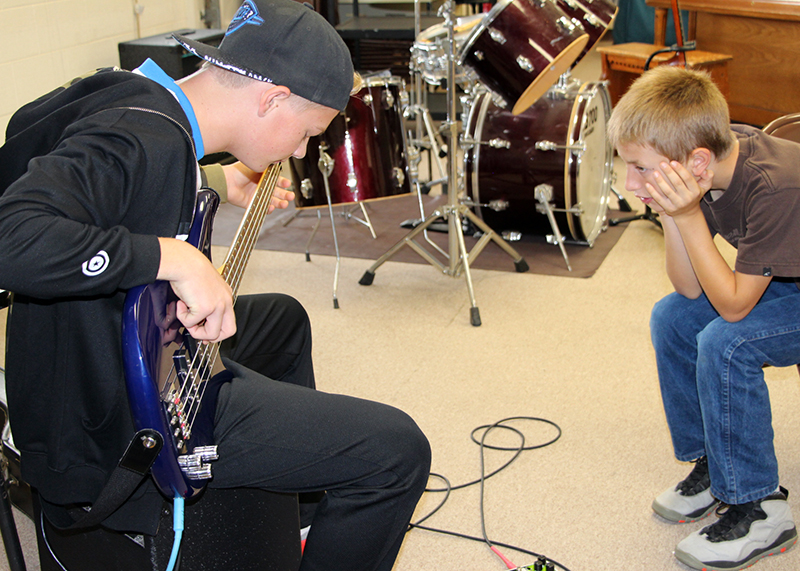
Photos by Campo School District
In tiny Campo, Colo., 42 students attend school only four days a week. In an innovative program, they designed their own fifth-day activities. The district bought a guitar and drum set after students expressed an interest in a rock band. Students both take lessons and teach others.
A surprising number of school districts across the nation have moved to a four-day school week. The trend, which gained ground during the Great Recession, has increased in the last decade.
Some observers see the extra day when students are not in school as a brand-new opportunity for innovative learning outside the classroom. Others fear that struggling students and those with less money won’t reap the benefits and will in fact lose ground.
“It’s mostly rural, remote and poor districts” that have four-day school weeks, said Georgia Heyward, research analyst for the Center for Reinventing Public Education. It’s a money-saving measure, although the cost savings are generally smaller than expected, she found. In most cases kids go to school for a longer time Monday through Thursday so their total class time remains the same.
Only about 1% of schools in the nation — 1,500 schools in 600 districts — have short school weeks, based on figures from economist Paul Thompson. Some states such as Minnesota have placed a moratorium on the practice, Hayward said.
The trend is centered in the intermountain states of Colorado, Wyoming and New Mexico.
Colorado leads the way with 109 of its 178 school districts having schools on a four-day week this year. Most are in rural areas, but some metro areas, including the Brighton suburb of Denver, have made the switch.
The short school week is not a new idea — South Dakota had a shorter week as far back as the 1930s, Hayward said.
In Campo, students get creative on fifth day
For Campo School Superintendent Nikki Johnson, the free day on Friday can provide important new opportunities for the 42 students in Campo’s very small school.
“Over the years we’ve tried different things,” she said, including “enrichment Fridays” and remedial classes to assist students. It was hard to get students to come, she said. But that changed in 2017. The trick was outside funding and a process that gave students a role in designing Friday programming.
In 2017, the Donnell-Kay Foundation made grants to Campo and four other rural Colorado districts to develop fifth-day programming. That summer, two students and two teachers from Campo attended a “design thinking” workshop in which they learned a process for getting input from all the students.
Back in Campo, they invited the school and community to weigh in.
“Students got to say what interested them,” Johnson said. “They brainstormed in groups and created a long list. … Everyone got to vote on the ones they would attend.”

Campo School Superintendent Nikki Johnson was surprised at the creative activities students wanted to do on their fifth day, including art lessons from local artist Sarah Steinman.
The things students wanted to do surprised her: ballroom dancing, photography, a rock band and more.
“Art was [also] one of the big things students asked for,” she said. It wasn’t offered during the school day.
The school brought in local artist Sarah Steinman to teach ceramics and painting. It also bought a drone, as well as a drum set and guitar for a rock band.
The school janitor of 30 years, Rolla Holbert, came with his wife to teach dancing. Kids learned square dancing, line dancing and the two-step. Holbert also did his Elvis impersonation at a school event.
Students did theater and produced a play. They had an art gala with a photography exhibit.
The grant to Campo was $25,000 for year one and $12,500 for year two. With the funds, the district hired a director and bought equipment.
While there is no money this year, the school is using the equipment and materials it previously purchased, Johnson said.
Developing unique interests
“Kids were really interested in being creative,” Johnson said. They were able to “shine in their unique interests.”
She described a shy sophomore who took the acting class and found a talent that none of the adults were aware of.
“She has really found her voice,” Johnson said.
Another sophomore is now giving guitar lessons to younger students. Yet another student had a particular interested in the cooking class.
“They really are able to explore something new to them and discover their own talents,” Johnson said.
The discovery of interests and mastery of skills helps kids thrive. It’s also a path to future careers, she said. “We may have a future chef.”
Problems with a four-day week
An issue around the shorter school week is that lIttle research exists to show the impact on students, said Heyward of CIPE. Some opponents fear the long school days are hard on the youngest students. Heyward hypothesized that English language learners could be negatively impacted as well as students whose parents have few resources for their children.
A study in Oregon by Thompson, the economist, found that low-income students did less well in reading in four-day-a-week schools. A Colorado study found a slight improvement in academic achievement while an Arizona study found no differences.
Teachers like the shorter school week and school districts think it helps recruit teachers.
On the plus side, the fifth day holds potential for new opportunities for kids.
[Related: AeroLab Thinks Four-day School Week Can Create Rural Jobs]
“That’s one of the more exciting aspects,” Hayward said.
The question is whether beneficial programming can be sustained — or even implemented.
In 2015 Heyward looked at districts in Idaho, when some were changing to a shorter week.
“There seemed to be a trend toward districts wanting to use that fifth day” with teachers or people in the community hoping to set up activities, she said.
School districts that had adopted a four-day schedule in the past told her: “Oh yes, we used to run a tutoring program …” she said.
“Over time it seemed like inertia would set in … or a grant would run out,” Hayward said.
Rural districts tend to have low college enrollment, a lot of poverty, limited opportunities and relatively low academic achievement measured on standardized tests, she said.
“If you’re a poor under-resourced district you’re not typically able … to set up additional bus routes or contract with community organizations,” to keep extra programs running, she said.
Elaine Menardi, who works with STEM education nonprofit Colorado AeroLab, started a fifth day program in 2018 in northwestern Colorado.
“Some districts have had four-day weeks a really long time. Most of them don’t do anything on that fifth day,” she said. “It’s really hard to get families out of the routine of a three-day weekend.”
However, she said newer adopters are trying to implement programs for the fifth day, and when school boards make the switch they do so with the promise of providing programming.
She sees enormous potential for Day Five.
To Heyward, the shift to four-day school is happening without enough thought.
There’s too little state attention to the issue, she said.
School districts aren’t thinking enough about the possibilities that a four-day week opens up or how they can provide fifth-day programs, she said. They are also not looking at possible pitfalls or sufficiently tracking the impact on students, she added.





























